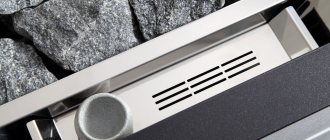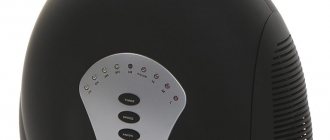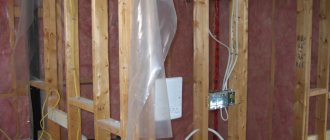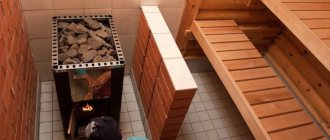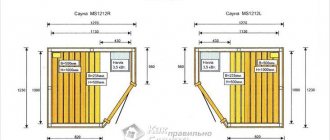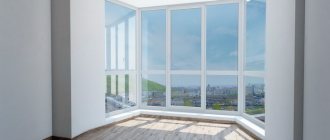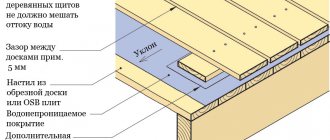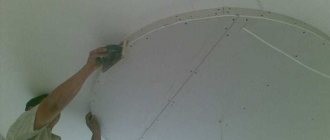Relative humidity is measured in a room - a value indicating the moisture saturation in the atmosphere. To find out the humidity in the house, you need to calculate the percentage of the maximum capacity and the actual amount of moisture. In everyday life, all complex calculations are done in a matter of seconds by special devices.
For interior design, you can use a composite board, as it does not deteriorate in any microclimate. This material consists of wood and polymers; thanks to this composition, this board is widely used in the interior: for terraces, the area around the pool, and interior decoration.
What are the dangers of dry and humid microclimates?
Residents of individual apartments most often think about the state of the air during the heating season. It is during the cold season, with the windows closed and heating devices running, that discomfort associated with dry air appears. However, excess moisture also has a bad effect on the well-being of the inhabitants of the house, provoking increased allergies, the development of bronchitis, asthma, and other respiratory diseases. The table describes the dangers of dry air and high humidity.
Table - The influence of excess and lack of moisture in the air on human health
| Deviation from the norm | Physical manifestation |
| Flaw | - Peeling, skin irritation; - brittle nails and hair; - inflammation, redness of the eyes; - dizziness, headache; - development of allergy to dust; - weakened immunity, - increased susceptibility to infections |
| Oversupply | — Creation of conditions for the development of fungus; - feeling of dampness; - the occurrence of frequent migraine attacks; - decreased performance; - appearance of lethargy, apathy |
Low humidity has an adverse effect on plants in the house - leaves turn yellow due to dryness and fall off. Wooden products, parquet, and musical instruments become very dry and deformed. Varnish coatings lose their attractiveness.
Problems arising from lack or excess moisture
Dry indoor air provokes increased moisture loss through the skin and respiratory tract. This can lead to such unpleasant consequences as:
- decreased elasticity of hair, nails and skin, accompanied by the appearance of microcracks, wrinkles, peeling, dermatitis;
- drying of the mucous membrane of the eyes, the symptoms of which are itching, redness, and a feeling of “sand”;
- thickening of the blood, leading to a slowdown in blood circulation, weakness, headaches, decreased performance, and increased stress on the heart;
- an increase in the viscosity of gastric and intestinal juices, causing a slowdown in digestion;
- drying out of the mucous membranes of the respiratory tract, which results in a weakening of local immunity and an increase in the frequency of acute respiratory viral infections;
- an increase in the amount of respiratory allergens in the atmosphere, which should normally be bound by liquid droplets.
Excess moisture in the air creates acceptable conditions for the growth of mold, fungi, and bacteria. As a result, you may encounter the following problems:
- 315
More details - 207 186
More details
- 1224 1163
More details
- 234
More details
- respiratory diseases - chronic runny nose, bronchitis, asthma, allergies; feeling of stuffiness or dampness in the room;
- unpleasant odor due to the proliferation of pathogenic microorganisms;
- increasing the drying time of washed laundry.
Excessive or insufficient amount of moisture in the house has a bad effect on the condition of home furnishings. Plants dry out or begin to rot, wooden furniture and parquet floors become deformed or “shrink,” paintings fade, paper products lose their structure.
What air humidity should be in an apartment according to GOST
Humidity indicators are regulated by state standards. Each functional room has its own norm at different times of the year. According to GOST, the following values are established for residential apartments in the cold and warm seasons:
- 30-60% - for winter, the maximum permissible value is 65%;
- 30-45% - in summer, maximum humidity level - 70%.
The standards must be observed by utility services when servicing an apartment building: it is the temperature and humidity that determine the beginning and end of the heating season. However, thanks to the use of household appliances, heating devices, and caring for indoor plants, each resident creates his own microclimate in a separate apartment.
Living space
The optimal air humidity in an apartment depends on the season, area of the room, temperature, availability of things, equipment. For example, indicators of 50% at a temperature of 25°C will not be considered the norm - such conditions are akin to the tropics. A favorable combination of air parameters for different rooms is presented in the table.
Table - Temperature and humidity ratio in different rooms
| Room | Average temperature, °C | Average humidity,% |
| Hallway | 19 | 45 |
| Bathroom | 22 | 45 |
| Toilet | 19 | 45 |
| Living room (common room) | 20 | 45 |
| Bedroom | 18 | 50 |
| Library | 20 | 35 |
| Kitchen | 20 | 45 |
| Children's | 21 | 55 |
Doctors recommend, regardless of the time of year and area of the room, to constantly maintain the norm at 45%. The lower humidity threshold is 30%, the upper one is 60%. It is better to keep the indicators within these values in order to prevent critical drying or waterlogging of the air with all the adverse consequences.
Children's
This room deserves special attention, because it is necessary to create favorable conditions for the newborn, eliminating all possible risks. The baby’s immune system cannot yet resist harmful microorganisms, and the body loses moisture very quickly.
The atmosphere in the nursery should be soft and warm. The nasopharynx should not be allowed to dry out. A “dry” nose is less resistant to infections and is more susceptible to colds. Dry atmosphere is harmful to delicate skin and can trigger the formation of atopic dermatitis.
Elevated temperatures with abundant moisture in the atmosphere are also undesirable for a child. If the baby does not sleep well and is capricious, one of the possible reasons is lack of air. It is necessary to ventilate the room in both cold and warm periods, maintaining the same temperature in any season. Favorable air humidity in the nursery is 50-60% at an average temperature of 22°C.
During colds, in order to avoid a runny nose, it is allowed to increase the humidity level in the children's room to 70%. The temperature should remain at 20-24°C.
Kitchen and bathroom
The microclimate in damp rooms requires constant “drying”. In large families, the kitchen is constantly cooking something on the stove, water is being used, and the bathroom often does not have time to ventilate before the next use. Therefore, it is important to install a powerful hood and proper ventilation in the kitchen and bathroom.
It is ideal if the bathroom has a window through which you can let in fresh air after water procedures. If this is not possible, leave the door open to release the accumulated steam. Poor exhaust hood and lack of ventilation often have undesirable consequences in the form of fungi and mold on the walls.
Houseware
An imbalance in humidity causes poor health in people, animals, and plants. Books, furniture, and linen deteriorate due to the lack or excess of moisture. For some items you need to increase the air humidity in the room, for others you need to lower it. The optimal humidity for different exhibits and things is presented in the table.
Table - Humidity standards for different household items
| Items | Humidity level,% |
| Wooden furniture | 40-60 |
| Books and documents | 30-60 |
| Houseplants (non-tropical species) | 40-70 |
| Lingerie, clothes | 40-50 |
| Electronics, household appliances | 45-60 |
Taking into account the fact that each room should have its own microclimate, objects and things should know their place. For example, it is better to free the bedroom from plants - they increase the moisture content in the air, but are afraid of drafts. Books have no place in the kitchen, and it is better to dry clothes not in the bathroom, but in a room with a large air flow.
The humidity level in the apartment is normal
The air we breathe is always filled to some extent with water vapor (we, of course, do not take into account desert regions that are not suitable for human life). Air humidity indicates the content of these vapors. It can be absolute and relative.
If we measure the volume of water in a cubic meter of air, we know its absolute humidity. Let's imagine that we took one cubic meter of air and found 13 g of water in it. This 13 g/m3 is its absolute humidity.
But if we want to calculate the relative humidity of the air, we will need to know two values: the maximum possible volume of water in a cubic meter of air (it depends on the temperature: the higher it is, the more moisture the air can hold) and the actual volume of water in a given cubic meter of air.
The percentage of the actual volume to the maximum possible will be the relative humidity of the air. For example, a cubic meter of air at a temperature of 24°C can contain a maximum of 21.8 g of water. If we find 13 g of water in it, then its relative humidity is about 60%.
What is the norm of humidity in an apartment indicated in official sources? Construction standards for Russia are prescribed in interstate GOST 30494-96 “Residential and public buildings. Indoor microclimate parameters."
According to this document, the optimal relative humidity in the cold season is 30-45%, and in the warm season – 30-60%. GOST also specifies limit values: in winter, according to the authors, it should not exceed 60%, and in summer – 65%.
It is worth remembering that the figures indicated by GOST are intended primarily not for residents of buildings, but for those who design and maintain these buildings.
This can be seen, for example, by the fact that the GOST standard for humidity in an apartment is lower in winter than in summer. This is due to the fact that during the cold season, the relative humidity of the outdoor air drops significantly when it warms up to room temperature.
It is difficult to design and maintain a building so that it can maintain “summer” humidity standards in winter without significant costs. But this does not mean that in winter the human body needs less moisture.
Physiologists recommend maintaining humidity in the apartment at 40-60%, regardless of the time of year.
How much humidity should be in the room? 30% humidity - the lower limit of the norm according to GOST - is felt by many as dry air with all the accompanying consequences. This humidity is also insufficient for most indoor plants: they will begin to dry out and wither. The optimal humidity for indoor flowers common in our latitudes is 40-70%.
Normal air humidity in an apartment in winter
- Particular attention should be paid to the issue of air humidity in the winter season. As we saw above, it is significantly lower due to a number of reasons, namely:
- radiator heating;
- additional heating devices;
- restriction in the flow of fresh air due to closed or sealed plastic windows.
All these factors affect not only the comfortable humidity in the apartment, but can also become an invisible source of health problems.
Acceptable humidity levels in premises are limited by the quantitative values specified in SanPiN. During inspections, measurements are carried out in accordance with GOST methods. Acceptable values for housing located in different climatic zones differ, and the required standards are not the same at different times of the year.
What percentage of humidity should be in the apartment?
Sanitary standards regulate the maximum relative humidity permissible in living rooms, which is 65% in summer, and 60% in the cold season.
Physiologists draw attention to the need to control minimum indicators, which at any time of the year should not be less than 40%. It is believed that ideal parameters for living rooms should have average values between 40% and 60%.
In winter, when heating a room, be it a private house or apartment, the humidity can drop sharply due to dry air. This must be monitored, if necessary, turning on the humidifier, opening the window for ventilation or installing baths with water.
In the winter season, any living space is heated. In the northern regions of the country it is especially intense due to severe frosts. Heat from radiators or underfloor heating dries out the air. This can be determined quite simply - drying out of the nasal and nasopharyngeal mucosa, this is especially noticeable after sleep.
It is these factors that lead not only to discomfort, but also to an increased risk of acute respiratory infections. We are more vulnerable when we sleep, so it is best to humidify the air at night or in the evening.
The optimal temperature for a full stay is considered to be +18…+24°C. Normal air humidity in the apartment should be 45−30%. The maximum allowable is 60%.
Air humidity in the apartment is normal for a child
A child's body copes worse with harmful environmental factors than an adult. Children freeze faster and overheat faster, catch colds easily, catch infections more often and suffer more severe illnesses.
Therefore, the microclimate in the nursery should help maintain the child’s body’s defenses, and humidity plays an important role here. The air should never be dry. In dry air, the child’s body intensively loses moisture.
The mucous membranes of the nasopharynx dry out and lose their ability to resist infections, the baby may experience itching in the eyes, and peeling may appear on sensitive skin.
The normal humidity level in an apartment for a child is considered to be 50-60%.
The famous children's doctor Evgeny Komarovsky insists on more: he calls 60% humidity the norm for a healthy child and recommends 70% for a baby who has caught an infection (the higher the air humidity, the less the mucous membranes dry out).
Important! Exceeding 24°C in a children's room can lead to overheating of the baby's body. As a result, drying of the mucous membranes and loss of fluid will accelerate.
The norm of humidity for a child in winter does not differ from summer. But there is an important point: in both winter and summer, it is advisable to maintain the temperature in the children’s room at no higher than 24°C. If the room is warmer, then a humidity of 60% will turn the nursery into the tropics.
You probably know from your own experience that high humidity is much more difficult to tolerate in hot weather than in cold weather. In addition, exceeding the specified temperature norm can cause overheating of the child’s body, which will, again, lead to loss of fluids, drying out of the mucous membranes and skin.
Comfortable indoor humidity for humans
The optimal level of air humidity is one of the components that ensure comfortable climatic conditions for human habitation. Moreover, each room, depending on its purpose, has its own microclimate.
Most often, people worry about the temperature and quality of air masses in the house, forgetting about this indicator. But it is the number of water (steam) molecules in the air that affects the perception of temperature by the human body, the safety of the indoor environment and the condition of plants.
Many people think that air humidity is an almost invisible indicator in the house, but this is not so. Surely many have seen the formation of condensation on glass during the cold season. This condensate is the excess moisture in the air.
It tends to condense where objects are coldest. This is why we see droplets on the windows.
The generally accepted average normal air humidity in an apartment should be 45%. It may vary depending on the type of room and its operating conditions.
Deviation from the norm is possible both in the winter season and in the warm period. In both cases, a lack or excess of humidity entails deterioration in human health, the condition of plants and damage to furniture, decoration, etc.
What should be the humidity in the apartment?
Optimal humidity and temperature parameters for individual rooms:
| Room | Air temperature, °C | Air humidity, % |
| Bedroom | 16-20 | 40-55 |
| Children's | 18-24 | 50-60 |
| Living room | 18-23 | 40-50 |
| Kitchen | 19-22 | 40-50 |
| Bathroom | 21-23 | 40-50 |
| Toilet | 16-19 | 40-45 |
| Study | 18-22 | 30-40 |
| Hallway | 18-19 | 40-45 |
| Greenhouse | 16-25 | 50-70 |
Rooms such as the kitchen, bathroom and toilet will always have a high level of moisture, so the standard for these rooms is higher than for other rooms.
Deviations from normal humidity have negative consequences. Thus, a low liquid content in the air leads to a large amount of liquid in the room. This is harmful not only from an aesthetic point of view, but also due to the negative impact on health, especially for those with allergies. Dry and dusty air can cause serious illnesses!
In addition, excessive dryness is fraught with damage to the skin and mucous membranes. If the comfortable air humidity is exceeded, a person will feel uncomfortable, furniture and antique items will be stored much worse than with normal liquid content in the room.
And also excessively humid air will become a real haven for all kinds of bacteria, including pathogenic ones. It causes the appearance of fungus and mold, dampness.
- In order for a person, plant or animal to be comfortable in a room, air humidity must be within certain limits:
- for people: 40-70%;
- for plants: 50-75%;
- for books, equipment, furniture: 40-60%.
How to find out the percentage: devices and “old-fashioned” methods
Knowing what air humidity is considered normal in an apartment, all that remains is to take the readings and compare them with the standard. Special devices and folk remedies will help you find out the level of humidity.
Hygrometer
The main device for measuring air humidity. The easiest one to use is electronic. Numbers, icons and emoticons clearly show the temperature and amount of moisture at a given time. The device can be placed on a table or moved to measure data in different parts of the apartment. Equipped with a sensitive sensor. Features of the electronic thermometer:
- runs on batteries;
- measures data accurate to tenths;
- responds instantly to changes in the environment;
- does not require configuration;
- has additional functions in some models - calendar, clock, weather forecast;
- costs from 700 to 2000 rubles (data as of November 2021).
Thermometer and Assmann table
Description. Using a room thermometer is an easy solution if you don't have a hygrometer at home. To take readings, in addition to a thermometer, you will need water, a cotton pad, a notepad, a pen and a table with data. The essence of the measurements is to identify the difference in the readings of the wet and dry thermometer.
Actions
- Record the room thermometer readings.
- Wet a cotton pad and wrap it around the glass head containing mercury.
- Wait five minutes.
- Record your readings.
- Subtract the second value from the first value.
- Find the data in Assmann's psychrometric table: the top row is the temperature difference, the column on the left is the data of the first measurement.
- Mark the number at the intersection of the data - this is relative humidity.
Cold water
Description. In this way it will not be possible to find out the exact value. Measurements are carried out “by eye” and take quite a lot of time. Completely dry glass indicates a dry atmosphere. If condensation persists, the humidity is average. Rapidly flowing drops of water are a sign of excess moisture.
Actions
- Place a half glass of cold water in the refrigerator.
- Leave to cool for three hours (the temperature will drop by about 5°C).
- Take it out and watch the walls of the glass for five minutes.
fir cone
Description. Coniferous trees are susceptible to moisture in the environment. The growth of seeds and, accordingly, the behavior of the cones depend on temperature and water.
Actions
- Place the fir cone away from the heating.
- Observe the scales for several hours.
- If there is an excess of moisture, the cone will close; if there is too little, it will open from drying out.
Knowing how air humidity in an apartment is measured, it is easy to adjust its level to create comfortable conditions. But what if you don’t have the device at hand? Pay attention to your own feelings, observe objects. Linen that takes a long time to dry in the room is not a sign of dryness, and peeling skin signals the need to moisturize the atmosphere.
A device for measuring indoor air humidity
A device that determines and displays the level of humidity is called a hygrometer, as already mentioned earlier. The principle of operation of the device is very simple, as it allows you to measure the humidity in the room as a whole and by examining each individual piece of furniture. A striking example is an ordinary hair hygrometer, which requires degreased human hair to carry out diagnostics.
The most common simple human hair can show what humidity is in the air, since if
:
- It is overdried, then it is correspondingly reduced;
- It's too fatty, then elevated.
No less in demand is a device called a film-type hygrometer, which is the most sensitive regarding the level of humidity, and an organic film is used to study the indicator.
There are other types of hygrometers, but it is not only not advisable to use them at home, but it will also not work, since they are directly related to industry.
It is worth noting that a hygrometer can give an error of 5% when identifying an indicator, but a psychrometer is the most accurate equipment that cannot lie. The simplest psychrometer has two sensors - dry and wet. The principle of operation is simple to the point of impossibility, since if the humidity is high, then the sensor set to moisture is triggered accordingly, and if it is low, then to dryness.
How to normalize indicators
Critical levels of 10-15% or 65-70% give rise to action to increase or decrease the humidity in the apartment. Automatic devices or improvised means will help to adjust the microclimate.
Promote
Humidifying the air in a room is quite simple - it is enough to provide an influx of steam, that is, moist air. There are seven ways to increase the amount of moisture in the atmosphere of an apartment.
- Electric humidifiers. The first thing you should do if the air in your apartment is dry is to buy a humidifier. Equipment stores offer steam, ultrasonic and traditional air softening devices. Each device has its pros and cons. Steam models work on the principle of a kettle: water boils and comes out, humidifying the air. The disadvantage is the large amount of electricity consumed. Ultrasonic, in addition to its main function, kills bacteria, but only distilled water or special cartridges are needed to work. Inexpensive models with a fan circulate air through the water tank, but make a lot of noise.
- A damp towel. You can easily cope with dryness without a humidifier by placing a wet towel on a hot radiator. The inconvenience is changing towels regularly: moisture evaporates very quickly. The problem will be solved by cans or basins, bandages folded in half. One end of the fabric is lowered into a container of water, the other is placed on the heating device. As moisture rises through the fabric, it will evaporate, humidifying the dry air.
- Dishes with water. Small open vessels are placed on shelves, cabinets, under radiators. Water evaporates slowly, but effectively humidifies the atmosphere. Add liquid approximately once a day.
- Aquarium. A container with colorful fish will decorate the room and help soften the atmosphere. The water in the aquarium is constantly renewed and slowly evaporates. You just need to feed the fish on time.
- Houseplants. Green pets control the atmosphere in the house, quickly reacting to drought, dampness and drafts, and also participate in creating the microclimate themselves. During the day, plants release oxygen, and at night they release carbon dioxide and moisture. Spraying the leaves will help quickly moisten the atmosphere.
- Fountain. You can combine business with pleasure with the help of a decorative fountain. Water circulation will give peace and saturate the air with moisture.
- Accumulated steam. It is recommended to dry clothes in the room and leave the bathroom door open so that excess moisture is distributed throughout the apartment.
Appliances and electronics operating in the same room - TV, computer, iron - greatly dry out the air. Therefore, you should think about the premises first.
Downgrade
Eliminating the cause of condensation will help get rid of humidity in your home. If dampness comes from the basement, sewer system, or appears due to faulty pipes, repairs should be made and the problem reported to utility services. Seven ways will help you get rid of excess moisture in an apartment or room.
- Dehumidifier. There are two types - stationary and mobile. Humid air settles in the operating device in the form of condensation, accumulating in the tank. When full, the device turns off automatically. Can work in cold, damp areas.
- Absorber. It is a device with a replaceable tablet that adsorbs air moisture. One tablet is designed for 20 square meters. m.
- Air conditioner. Absorbs excess moisture like a dehumidifier. It can work at different times of the year, maintaining a favorable microclimate.
- Oil radiator. The device increases the temperature and “dries” the air. The radiator should be turned off periodically so as not to exceed the dryness level.
- Ventilation. Necessary at any time of the year, in frosts and off-season. During frosty weather, it is recommended to open the window for five minutes. This will help refresh the air while keeping the room warm. In the bedroom, it is better to keep the window slightly open at all times, closing it for a while when the temperature drops sharply.
- Sun rays. The sun dries damp linen, pillows, chairs, and warms up the entire room. On sunny days, especially after prolonged rains, you should pull back the curtains and “let in” the sun through the windows and balcony door.
- Candles. Even one lit candle effectively absorbs moisture, drying the air. It should be remembered that oxygen is also burned along with moisture, so it is necessary to ensure air flow.
Moisture is actively absorbed by soft toys, carpets, and furniture. However, this is not the best way to deal with humidity: dampness accumulates in products and provokes the development of mold. Toys, mattresses, furniture and pillows must be dried periodically in the sun.
Maintaining the level of air humidity in the apartment will ensure healthy well-being for all family members, pets and plants. To regulate the microclimate, you should properly operate heating devices, use humidifiers, and ventilate the apartment more often.
